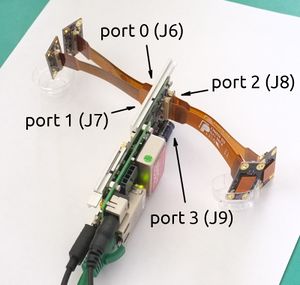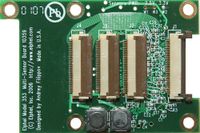Difference between revisions of "Using 10359 mux with 10393"
From ElphelWiki
(→Firmware image) |
(→Connection) |
||
| (3 intermediate revisions by the same user not shown) | |||
| Line 2: | Line 2: | ||
===Firmware image=== | ===Firmware image=== | ||
| − | [https://community.elphel.com/files/393/ | + | [https://community.elphel.com/files/393/20171120/ '''20171120'''] or required apps-autocampars version is at least 1.0.52 |
root@elphel393:~# cat /etc/elphel393/packages/apps-autocampars | root@elphel393:~# cat /etc/elphel393/packages/apps-autocampars | ||
| − | 1.0. | + | 1.0.52 |
===Connection=== | ===Connection=== | ||
| Line 12: | Line 12: | ||
* cable sides as described [[10359#Connect_10353.2C_10359_and_sensors|here]] | * cable sides as described [[10359#Connect_10353.2C_10359_and_sensors|here]] | ||
* a mux board can be connected to any sensor port | * a mux board can be connected to any sensor port | ||
| − | * up to 4x mux boards at the same time ( | + | * up to 4x mux boards at the same time (up to 4x do not require extra power modifications if 10389 is not connected) |
* sensor boards can be connected to any unused ports | * sensor boards can be connected to any unused ports | ||
[[File:10359top.jpeg|thumb|200px|Fig.2 10359 mux board (older revision)]] | [[File:10359top.jpeg|thumb|200px|Fig.2 10359 mux board (older revision)]] | ||
| − | * if the number of connected mux boards is | + | * <font color='red'>'''if the number of connected mux boards is 1+ and internal SSD is used then extra power is needed'''</font> (a lot depends on SSD power consumption): |
quick mod: see Fig.2 | quick mod: see Fig.2 | ||
lift pins 3,4 on J1, put teflon tape under them and solder a wire to those lifted pins connected. Then add a MOS transistor or a switch that will apply external 3.3 V to W2 when those J1.3, J1.4 have | lift pins 3,4 on J1, put teflon tape under them and solder a wire to those lifted pins connected. Then add a MOS transistor or a switch that will apply external 3.3 V to W2 when those J1.3, J1.4 have | ||
| Line 23: | Line 23: | ||
===Modified device tree=== | ===Modified device tree=== | ||
| − | Download and use this [ | + | Download and use this [https://community.elphel.com/files/393/mux_board_dts/10359/devicetree.dtb devicetree.dtb]. The easiest way is to overwrite the device tree on the BOOT partition of a recovery SD card and then boot from it. |
===Application mask (assuming 10389 is not connected)=== | ===Application mask (assuming 10389 is not connected)=== | ||
Latest revision as of 14:37, 10 January 2018
Contents
[hide]Setup
Firmware image
20171120 or required apps-autocampars version is at least 1.0.52
root@elphel393:~# cat /etc/elphel393/packages/apps-autocampars 1.0.52
Connection
- cable sides as described here
- a mux board can be connected to any sensor port
- up to 4x mux boards at the same time (up to 4x do not require extra power modifications if 10389 is not connected)
- sensor boards can be connected to any unused ports
- if the number of connected mux boards is 1+ and internal SSD is used then extra power is needed (a lot depends on SSD power consumption):
quick mod: see Fig.2 lift pins 3,4 on J1, put teflon tape under them and solder a wire to those lifted pins connected. Then add a MOS transistor or a switch that will apply external 3.3 V to W2 when those J1.3, J1.4 have power.
Modified device tree
Download and use this devicetree.dtb. The easiest way is to overwrite the device tree on the BOOT partition of a recovery SD card and then boot from it.
Application mask (assuming 10389 is not connected)
Without the 10389 the application mode is set in /etc/elphel393/default_10389.xml
root@elphel393:~# cat /etc/elphel393/default_10389.xml
<?xml version="1.0" standalone="yes"?>
<board>
<model>10389 not present</model>
<rev>B</rev>
<serial>F80000</serial>
<app>MT9P006</app>
<mode>15</mode>
</board>
To edit on the camera, use nano:
ssh root@192.168.0.9 root@elphel393:~# nano /etc/elphel393/default_10389.xml
To enable programming mux board(s) - set corresponding bits in [19:16]=0x?, [15:0]=0x7777 - then convert to decimal. Examples:
- mux on port 0 (bit 16):
<mode>96119</mode> (=0x17777)
- mux on port 3 (bit 19):
<mode>554871</mode> (=0x87777)
- 2 mux boards on port 1 & 2:
<mode>423799</mode> (=0x67777)
Then
root@elphel393:~# sync root@elphel393:~# reboot -f
Phase adjustments
- For each port with incorrect sensor phase. A quick link for port 0:
http://192.168.0.9/parsedit.php?sensor_port=0&TESTSENSOR&SENSOR_PHASE&MULTI_PHASE1&MULTI_PHASE2&MULTI_PHASE3
TESTSENSOR - test pattern mode SENSOR_PHASE - mux or single sensor phase MULTI_PHASE1 - mux port 0 (J2) MULTI_PHASE2 - mux port 1 (J3) MULTI_PHASE3 - mux port 2 (J4)
- inspect image
- TESTSENSOR=0x10008 - color bars mode, see Fig.3
- MULTI_PHASE1=0x10000 (this worked for the tested setup)
- MULTI_PHASE2=0x10000
- MULTI_PHASE3=0x10050
Note: I had a script somewhere for auto adjustment
- Save configuration (for port 0):
http://192.168.0.9/autocampars.php?sensor_port=0
More details
device tree
- decompile device tree
~$ dtc -I dtb -O dts -o devicetree.dts devicetree.dtb
- the only change that is made to work with the mux board is:
-elphel393-detect_sensors,port-mux = "none none none none"; +elphel393-detect_sensors,port-mux = "detect detect detect detect";
- compile device tree
~$ dtc -I dts -O dtb -o devicetree.dtb devicetree.dts
if 10389 is connected
Go to http://community.elphel.com/bootblock393/ and program 10389 EEPROM
- Enter camera's IP address in the 1st block (top-left)
- In the 2nd block:
- Read AUX
- Set
Application = MT9P006 Application mode = as described for 10389-less setup
- Program AUX
- Reboot


